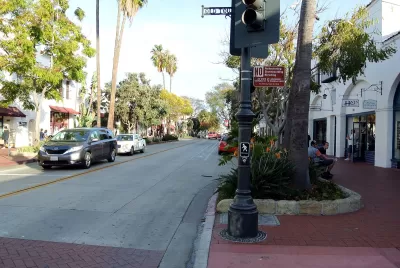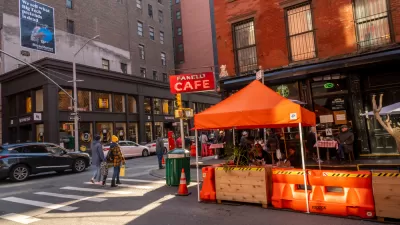The city will consider adjustments to its outdoor dining policy after the fire department expressed concerns about access for emergency vehicles.

Social distancing restrictions imposed during the pandemic forced cities to rapidly implement outdoor dining programs, and Santa Barbara, with its bustling downtown restaurant scene, was no exception. Now, at the Fire Department's request, the city may remove or alter around 25 outdoor seating areas approved under the COVID-19 program. As John Palminteri reports, "The Santa Barbara City Fire Department says it needs 20-feet down the middle of the street in the area where they only have a space of 14 and a half feet," a number that the fire department previously agreed to.
The city is now evaluating the regulations for its outdoor dining program and plans to amend the rules to address concerns from first responders, business owners, and local residents, as well as other design changes for the city's downtown.
Although the concept of parklets—public or private seating or dining areas created from curbside or surface parking—has been around for years, COVID-19 led to an explosion of "pandemic dining" projects, with cities scrambling to create regulations and balance the need for more outdoor dining and seating with traditional street uses and user safety concerns. Cities around the country embraced "al fresco dining" and "open streets," inadvertently creating models for what could be permanent fixtures of future cities, where street space is reimagined to serve a broader segment of users and purposes.
FULL STORY: Many parklets and patios could be cut back in the Santa Barbara promenade by early March

Planetizen Federal Action Tracker
A weekly monitor of how Trump’s orders and actions are impacting planners and planning in America.

Congressman Proposes Bill to Rename DC Metro “Trump Train”
The Make Autorail Great Again Act would withhold federal funding to the system until the Washington Metropolitan Area Transit Authority (WMATA), rebrands as the Washington Metropolitan Authority for Greater Access (WMAGA).

The Simple Legislative Tool Transforming Vacant Downtowns
In California, Michigan and Georgia, an easy win is bringing dollars — and delight — back to city centers.

The States Losing Rural Delivery Rooms at an Alarming Pace
In some states, as few as 9% of rural hospitals still deliver babies. As a result, rising pre-term births, no adequate pre-term care and "harrowing" close calls are a growing reality.

The Small South Asian Republic Going all in on EVs
Thanks to one simple policy change less than five years ago, 65% of new cars in this Himalayan country are now electric.

DC Backpedals on Bike Lane Protection, Swaps Barriers for Paint
Citing aesthetic concerns, the city is removing the concrete barriers and flexposts that once separated Arizona Avenue cyclists from motor vehicles.
Urban Design for Planners 1: Software Tools
This six-course series explores essential urban design concepts using open source software and equips planners with the tools they need to participate fully in the urban design process.
Planning for Universal Design
Learn the tools for implementing Universal Design in planning regulations.
Smith Gee Studio
City of Charlotte
City of Camden Redevelopment Agency
City of Astoria
Transportation Research & Education Center (TREC) at Portland State University
US High Speed Rail Association
City of Camden Redevelopment Agency
Municipality of Princeton (NJ)





























